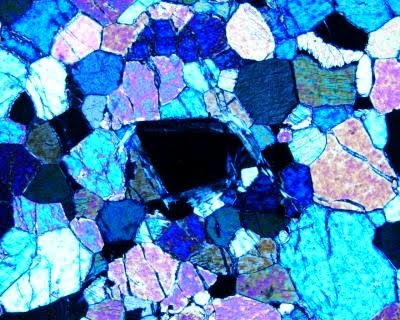Philosophy

Potassium ferrocyanide {K4[Fe(CN)6]•3H2O} [yellow prussiate of potash or potassium hexacyanoferrate(II)]...Potassium ferricyanide {K3[Fe(CN)6]} These two chemicals have had a colorful history...even their chemistry has been cloudy. But now it is believed that they are participants in the formation of living organisms.
A team of researchers from the Astrobiology Centre (INTA-CSIC) has shown that hydrogen cyanide, urea and other substances considered essential to the formation of the most basic biological molecules can be obtained from the salt Prussian blue. In order to carry out this study, published in the journal Chemistry & Biodiversity, the scientists recreated the chemical conditions of the early Earth.
"We have shown that when Prussian blue is dissolved in ammoniac solutions it produces hydrogen cyanide, a substance that could have played a fundamental role in the creation of the first bio-organic molecules, as well as other precursors to the origin of life, such as urea, dimethylhydantoin and lactic acid", Marta Ruiz Bermejo, lead author of the study and a researcher at the Astrobiology Centre (CSIC-INTA), tells SINC.
Urea is considered to be an important reagent in synthesising pyrimidines (the derivatives of which form part of the nucleic acids DNA and RNA), and it has been suggested that hydantoins could be the precursors of peptides and amino acids (the components of proteins), while lactic acid is also of biological interest because, along with malic acid, it can play a role in electron donor-recipient systems.
The researcher and her team have proved that these and other compounds originate from the cyanide liberated by the salt Prussian blue (the name of which refers to the dye used in the uniforms of the Prussian Army) when it is subjected for several days to conditions of pH12 and relatively high temperatures (70-150ºC) in a damp, oxygen-free ammoniac environment, similar to early conditions on Earth. The results of the study have been published recently in the journal Chemistry & Biodiversity.
"In addition, when Prussian blue decomposes in this ammoniac, anoxic environment, this complex salt, called iron (III) hexacyanoferrate (II), also turns out to be an excellent precursor of hematite, the most stable and commonly found form of iron (III) oxide on the surface of the Earth", explains Ruiz Bermejo.
Hematite is related to the so-called Banded Iron Formations (BIF), the biological or geological origin of which is the source of intense debate among scientists. The oldest of these formations, more than two billion years old, have been found in Australia.
The researchers have confirmed in other studies that Prussian blue can be obtained in prebiotic conditions (from iron ions in methane atmosphere conditions with electrical discharges). The synthesis of this salt and its subsequent transformation into hematite offers an alternative model to explain the formation of the banded iron in abiotic conditions in the absence of oxygen.
Ruiz Bermejo concludes that Prussian blue "could act as a carbon concentrator in the prebiotic hydrosphere, and that its wet decomposition in anoxic conditions could liberate hydrogen cyanide and cyanogen, with the subsequent formation of organic molecules and iron oxides".
Potassium Ferricyanide
Potassium Ferrocyanide
Prussian Blue

Supplimental...photographic applications.
These two chemicals have been used in photography for a long time as a silver halide reducer [bleach] and cyanotypes ["ferro prussiate"].
Cyanotype
Cyanotype printing with Dr Mike Ware
- What A Waste...chemist Convicted Of Murder
"Chemist found guilty of murder" by Laura Howes July 17th, 2013 Chemistry World A chemist in the US has been found guilty of killing her husband with thallium obtained from the Bristol-Myers Squibb (BMS) lab where she worked. Tianle Li, 43, was also...
- The "goo" Of Life
Stanley Miller in his UC San Diego lab in 1970 "Origin of Life: An Old Experiment Yields New Clues" by Michael D. Lemonick March 22nd, 2011 Time Jeffrey Bada was comparing notes with his colleague Antonio Lazcano a couple of years ago, when something...
- Miller Experiment--another Look
Apparatus Used In The Original Miller Experiment. "Prebiotic Soup--Revisiting the Miller Experiment" by Jeffrey L. Bada and Antonio Lazcano "Isn't life wonderful?" sang Alma Cogan and Les Howard in their almost forgotten 1953 hit. That same year,...
- Matrix Of "life Forms"
Maybe something can be learned from science fiction...not all life forms are carbon based and need water. "'Life as we don't know it' in the universe? Start with Titan" Saturn's frigid moon Titan is not a candidate for Earth-like life....
- Tribute To Leslie E. Orgel And Stanley L. Miller
Volume 15 Number 1 July 2009 Hyle Book review: Piet Herdewijn & M. Volkan Kisakürek (eds.): Origin of Life: Chemical Approach, Zürich: VCHA & Weinheim: Wiley-VCH, 2008, xii + 418 pp. [ISBN 978-3-906390-50-5] by George B. Kauffman Whereas...
Philosophy
Prussian Blue and origin of life

Potassium ferrocyanide {K4[Fe(CN)6]•3H2O} [yellow prussiate of potash or potassium hexacyanoferrate(II)]...Potassium ferricyanide {K3[Fe(CN)6]} These two chemicals have had a colorful history...even their chemistry has been cloudy. But now it is believed that they are participants in the formation of living organisms.
"Prussian Blue and the Origin of Life"
December 22nd, 2009
Astrobiology
December 22nd, 2009
Astrobiology
A team of researchers from the Astrobiology Centre (INTA-CSIC) has shown that hydrogen cyanide, urea and other substances considered essential to the formation of the most basic biological molecules can be obtained from the salt Prussian blue. In order to carry out this study, published in the journal Chemistry & Biodiversity, the scientists recreated the chemical conditions of the early Earth.
"We have shown that when Prussian blue is dissolved in ammoniac solutions it produces hydrogen cyanide, a substance that could have played a fundamental role in the creation of the first bio-organic molecules, as well as other precursors to the origin of life, such as urea, dimethylhydantoin and lactic acid", Marta Ruiz Bermejo, lead author of the study and a researcher at the Astrobiology Centre (CSIC-INTA), tells SINC.
Urea is considered to be an important reagent in synthesising pyrimidines (the derivatives of which form part of the nucleic acids DNA and RNA), and it has been suggested that hydantoins could be the precursors of peptides and amino acids (the components of proteins), while lactic acid is also of biological interest because, along with malic acid, it can play a role in electron donor-recipient systems.
The researcher and her team have proved that these and other compounds originate from the cyanide liberated by the salt Prussian blue (the name of which refers to the dye used in the uniforms of the Prussian Army) when it is subjected for several days to conditions of pH12 and relatively high temperatures (70-150ºC) in a damp, oxygen-free ammoniac environment, similar to early conditions on Earth. The results of the study have been published recently in the journal Chemistry & Biodiversity.
"In addition, when Prussian blue decomposes in this ammoniac, anoxic environment, this complex salt, called iron (III) hexacyanoferrate (II), also turns out to be an excellent precursor of hematite, the most stable and commonly found form of iron (III) oxide on the surface of the Earth", explains Ruiz Bermejo.
Hematite is related to the so-called Banded Iron Formations (BIF), the biological or geological origin of which is the source of intense debate among scientists. The oldest of these formations, more than two billion years old, have been found in Australia.
The researchers have confirmed in other studies that Prussian blue can be obtained in prebiotic conditions (from iron ions in methane atmosphere conditions with electrical discharges). The synthesis of this salt and its subsequent transformation into hematite offers an alternative model to explain the formation of the banded iron in abiotic conditions in the absence of oxygen.
Ruiz Bermejo concludes that Prussian blue "could act as a carbon concentrator in the prebiotic hydrosphere, and that its wet decomposition in anoxic conditions could liberate hydrogen cyanide and cyanogen, with the subsequent formation of organic molecules and iron oxides".
Potassium Ferricyanide
Potassium Ferrocyanide
Prussian Blue

Supplimental...photographic applications.
These two chemicals have been used in photography for a long time as a silver halide reducer [bleach] and cyanotypes ["ferro prussiate"].
Cyanotype
Cyanotype printing with Dr Mike Ware
- What A Waste...chemist Convicted Of Murder
"Chemist found guilty of murder" by Laura Howes July 17th, 2013 Chemistry World A chemist in the US has been found guilty of killing her husband with thallium obtained from the Bristol-Myers Squibb (BMS) lab where she worked. Tianle Li, 43, was also...
- The "goo" Of Life
Stanley Miller in his UC San Diego lab in 1970 "Origin of Life: An Old Experiment Yields New Clues" by Michael D. Lemonick March 22nd, 2011 Time Jeffrey Bada was comparing notes with his colleague Antonio Lazcano a couple of years ago, when something...
- Miller Experiment--another Look
Apparatus Used In The Original Miller Experiment. "Prebiotic Soup--Revisiting the Miller Experiment" by Jeffrey L. Bada and Antonio Lazcano "Isn't life wonderful?" sang Alma Cogan and Les Howard in their almost forgotten 1953 hit. That same year,...
- Matrix Of "life Forms"
Maybe something can be learned from science fiction...not all life forms are carbon based and need water. "'Life as we don't know it' in the universe? Start with Titan" Saturn's frigid moon Titan is not a candidate for Earth-like life....
- Tribute To Leslie E. Orgel And Stanley L. Miller
Volume 15 Number 1 July 2009 Hyle Book review: Piet Herdewijn & M. Volkan Kisakürek (eds.): Origin of Life: Chemical Approach, Zürich: VCHA & Weinheim: Wiley-VCH, 2008, xii + 418 pp. [ISBN 978-3-906390-50-5] by George B. Kauffman Whereas...
